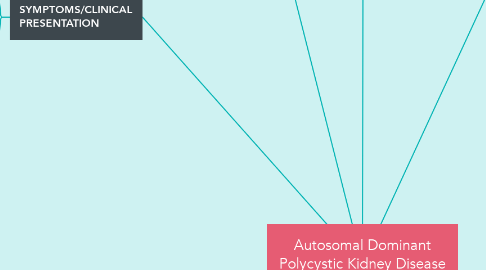
1. RISK FACTORS FOR PROGRESSIVE/END STAGE RENAL DISEASE
1.1. (Torres & Bennett, 2019)
1.2. Presence of mutated PKD1 or PKD2 genes
1.3. Large kidney size/growth
1.4. Hypertension
1.5. Early onset of symptoms
1.6. Male gender is associated with more rapid progression of PKD1
1.7. Patients with proteinuria, high urinary sodium excretion, and significantly decreased GFR (Glomerular filtration rate)
2. SYMPTOMS/CLINICAL PRESENTATION
2.1. (Torres & Bennett, 2019)
2.2. Presence of renal cysts
2.2.1. PKD1 mutations have larger kidneys and greater number of cysts than PKD2 mutations
2.3. Hypertension
2.4. Renal function impairment
2.4.1. Proteinurina
2.4.2. Hematuria
2.5. Flank/abdominal pain
2.6. Urinary tract infection
2.7. Headache
2.8. Extra-renal manifestations with advanced stage ADPKD
2.8.1. Cerebral aneurysms
2.8.2. Hepatic and pancreatic cysts
2.8.3. Cardiac valve disease
2.8.4. Colonic diverticula
2.8.5. Abdominal wall and inguinal hernia
2.8.6. Seminal vesicle cysts
2.8.7. Ascending aorta aneurysms and dissections
2.9. Most patients die from cardiac causes such as heart disease, coronary disease, and/or infection
3. DIAGNOSIS
3.1. (Torres & Bennett, 2019)
3.2. Commonly diagnosed on routine evaluation in asymptomatic patient with a positive family history of ADPKD
3.3. Cysts are often discovered incidentally on abdominal ultrasound imaging for other reasons such as pregnancy
3.4. Diagnosis is established by family history and ultrasound. CT or MRI can also establish diagnosis, but kidney function should be healthy.
3.4.1. If patient has no family history of ADPKD, diagnosis is established with the presence of 10 or more cysts (greater than 5mm) in each kidney
3.5. Genetic testing. This is used less frequently to make the diagnosis due its high cost and inaccuracy for 15% of cases.
4. TREATMENT
4.1. (Muller & Benzing, 2018)
4.1.1. (Chapman et al., 2019)
4.2. Treatment focuses on slowing the progression to end stage renal failure.
4.3. Initial management
4.3.1. Blood pressure control using an ACE inhibitor or ARB.
4.3.2. Dietary sodium restriction to 2 grams per day or less.
4.3.3. Increase fluid intake (3L/day) to suppress plasma vasopressin levels, which has shown to inhibit cyst growth.
4.3.4. Increase fluid intake to suppress plasma vasopressin levels to inhibit cyst growth
4.3.5. Dietary sodium restruction to 2 grams per day or less
4.4. Pharmacological management for high-risk patients
4.4.1. Tolvaptan (vasopressin receptor 2 antagonist) to slow progression of ADPKD.
4.5. End-stage renal disease management
4.5.1. Kidney transplantation and/or nephrectomy
4.5.2. Hemodialysis
4.5.3. Peritoneal dialysis
5. EPIDEMIOLOGY
5.1. (Torres & Bennett, 2019)
5.2. Occurs in all races
5.3. Prevalence of 1:1000 live births in the United States
5.4. 5% of dialysis patients have ADPKD as an underlying cause of kidney disease
6. GENETICS
6.1. (Nobakht et al., 2020)
6.1.1. (Pei et al., 2018)
6.2. Mutations of two genes:
6.2.1. PKD1
6.2.1.1. Gene is located on chromosome 16p13.3 and it encodes protein polycystin-1
6.2.2. PKD2
6.2.2.1. Gene is located on chromosome 4q21 and it encodes protein polycystin-2
6.3. PKD1 and PKD2 can have synergestic effects
6.4. Patients with PKD2 develop fewer cysts and have disease progression more slowly than those with PKD 1
6.5. Autosomal dominant inheritence pattern which allows for prediction of the mutation based upon family history
6.5.1. Each child of one affected parent has a 50% chance of inheriting this disease
6.6. Majority of mutations are frameshift deletions/insertions
6.7. (Pei et al., 2018)
6.7.1. Nobakht et al. (2020)
7. PATHOPHYSIOLOGY
7.1. (Pei et al., 2018)
7.1.1. (Ring & Huether, 2019)
7.1.1.1. (Torra, 2020)
7.2. Polycystins regulate growth and differentiation of the tubular epithelium.
7.2.1. Defects in the formation of epithelial cells and their cilium result in cyst formation and subsequent obstruction.
7.2.1.1. This leads to destruction of renal parenchyma, interstitial fibrosis, and loss of functional nephrons.
7.2.1.2. Each epithelial cell within a renal tubule has a germ-line mutation with ADPKD, but only a tiny fraction of the tubules develop renal cysts.
7.3. As the fluid-filled cysts expand and proliferate, tertiary changes within the renal interstitium also result.
7.3.1. Fibrosis within the interstitium begins early in the course of the disease.
7.3.2. Cellular proliferation and fluid secretion is promoted by cAMP and growth factors such as epidermal growth factor (EGF).
